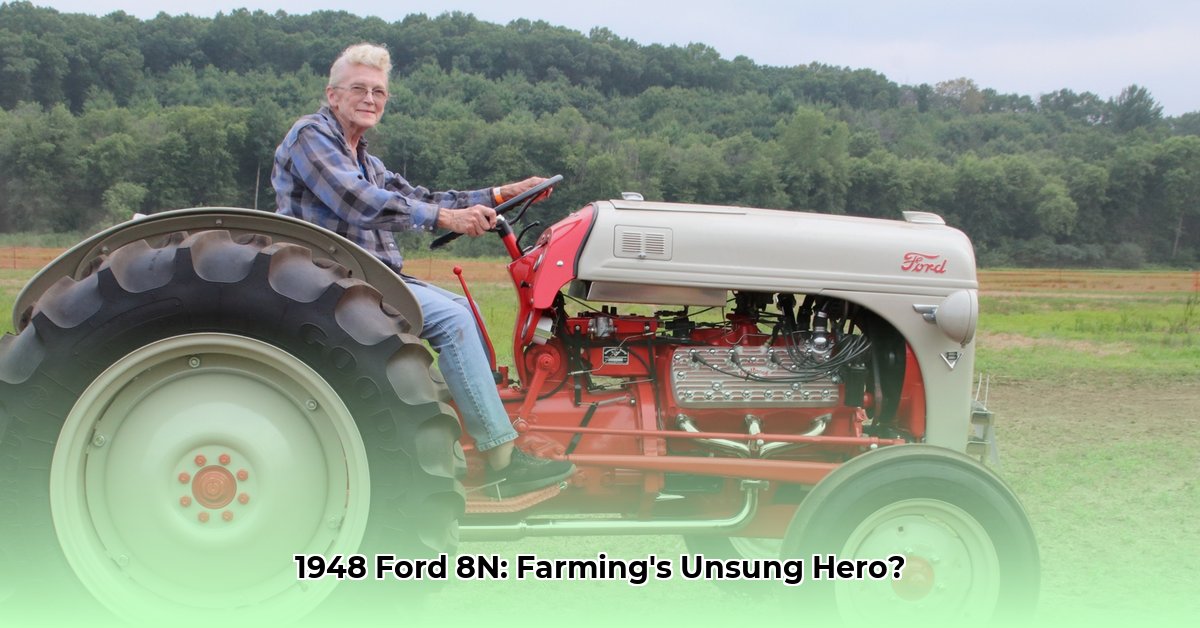
The 8N: A Simple Machine, Big Impact
The 1948 Ford 8N tractor, a ubiquitous symbol of post-war agriculture, wasn't just a machine; it represented a significant technological leap. Its straightforward design—a stark contrast to today's complex machinery—was revolutionary. Fewer parts meant easier maintenance and less downtime. This simplicity, akin to a sturdy, reliable watch, offers surprising advantages in today's sustainability-focused world. Farmers could often perform repairs themselves, minimizing reliance on expensive mechanics and fostering a "repair, don't replace" ethos. Isn't this inherent resilience a key element of sustainable practices? For more detailed information, check out these free 8N manuals.
The 8N and Sustainable Agriculture: A Double-Edged Sword
This vintage tractor presents both opportunities and limitations in the context of modern sustainable agriculture.
Advantages:
- Easy Repair and Maintenance: The 8N's uncomplicated design makes repairs simpler and cheaper, minimizing waste from discarded equipment. Many owners find satisfaction in restoring their 8Ns, highlighting a sustainable "repair, don't replace" philosophy.
- Longevity: Numerous 8Ns are still operational, demonstrating their durability and contributing to resource conservation by reducing the need for frequent replacements. This long lifespan directly reduces the environmental impact associated with manufacturing new machinery.
- Lower Initial Carbon Footprint (Potentially): Given its manufacturing decades ago, its initial carbon footprint may be lower than modern tractors, although further investigation is needed to quantify this aspect precisely.
Disadvantages:
- Fuel Inefficiency: Its fuel consumption is significantly higher than modern tractors, leading to increased greenhouse gas emissions. This is a substantial drawback in today's sustainable agriculture movement.
- Limited Capabilities: Compared to modern counterparts, the 8N's capabilities are restricted, potentially leading to higher labor costs and inefficiencies. This can result in more extensive energy use overall to achieve the same output.
- Parts Availability: Sourcing replacement parts can be challenging, although creative solutions such as 3D printing are emerging within the enthusiastic restoration community.
Challenges and Opportunities in the 21st Century
The 8N's enduring legacy presents challenges and opportunities. Sourcing parts is difficult; however, resourceful owners are exploring 3D printing and other innovative solutions. The fuel inefficiency issue is also a significant hurdle. Yet, the potential to adapt this tractor to alternative fuels offers exciting possibilities for increased sustainability.
Preserving the Past, Shaping the Future
The 1948 Ford 8N is more than a vintage tractor; it's a valuable educational tool, showcasing the evolution of agricultural technology. Restoration enthusiasts actively contribute to its longevity, embodying a circular economy approach. Research into alternative fuels and engine modifications for the 8N offers exciting potential for sustainable adaptation of older technologies.
How to Reduce Emissions from a Vintage Ford 8N Tractor
The 8N's environmental footprint is a balancing act. While its longevity reduces the overall environmental impact, its fuel inefficiency contributes to higher greenhouse gas emissions. Optimization is key to minimizing its negative environmental effects.
Optimizing the 8N for Efficiency: Practical Steps
- Carburetor Tuning: Proper carburetor tuning (e.g., adjusting the Marvel-Schebler carburetor) is crucial for fuel efficiency. Start with the recommended settings, then fine-tune iteratively for optimal performance.
- Fuel System Maintenance: Using clean fuel and regularly changing fuel filters is critical for optimal performance and emission reduction.
- Engine Maintenance: Regular oil changes, spark plug replacements, and general engine care significantly improve fuel economy and reduce emissions.
- Driving Practices: Minimize idling to maximize fuel efficiency.
Key Takeaways and Future Directions
- The 8N's enduring legacy highlights the complex interplay between historical technology and modern sustainability needs.
- Optimizing the 8N for efficiency through careful maintenance and fuel management can significantly reduce emissions.
- Innovative approaches such as exploring alternative fuels and adapting older technologies offer substantial potential for sustainable practices in agriculture.
Three Pivotal Points:
- The Ford 8N's simple design fostered a "repair, don't replace" mentality, aligning with sustainable practices.
- While fuel-inefficient, its longevity reduces the overall environmental impact compared to frequent replacements.
- Adapting the 8N to alternative fuels offers a significant opportunity for enhanced sustainability.